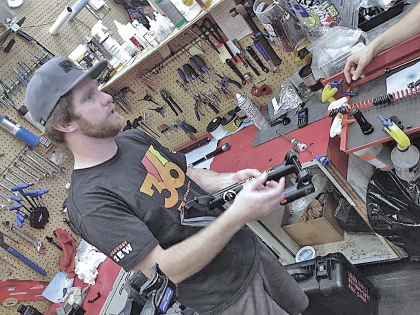When Fox announced their new 36, they went directly after the Pike. This isn’t surprising. The Pike is a damn good fork, mixing a combination of low-speed suppleness and high-speed support seldom found on mountain bike suspension. Fox has obviously felt the hit from the Pike, and they’ve come out swinging.
Much like their 40 Float released a couple of years ago, Fox’s 36 is a completely new product. The lower assembly has been re-designed, the RC2 Damper is unique, the air spring was radically overhauled, and even the famed Kashima coating got a makeover.
To get us started on the new fork, Fox sent a couple for testing. One went to Scott for technical teardown; the other went to Parker for thrashing. In addition, Fox’s Outside Tech Rep, Louis Angeley, stopped by the shop to tear down the fork and put it back together again. While Scott got a few good rides before he went under the knife for his shoulder, Parker took his new fork and went racing. The first weekend Parker hit the Big Mountain Enduro in Snowmass, and the following weekend he raced in Sun Valley at their NAET-Sanctioned Enduro.
So far, we’re impressed.
Squish Test
In short, it passed the squish test. For anyone who has pushed on a Pike, that initial breakaway suppleness is an inviting characteristic. The pike has as little drag as we’ve felt in any bicycle fork. While the Fox 36 isn’t quite as supple off the top, it is significantly better than any Fox we’ve ever squished before.
Compared to the Pike, the Fox isn’t as supple initially, but it has remained consistent through two weeks of hard riding in dusty conditions. The same cannot be said for the Pike. It feels great initially, but it takes a good amount of regular care to keep it working optimally.
We never thought we’d be touting a Fox Fork for its durability, but in this comparison of lightweight, long-travel race forks, the Fox has won out. It will still need regular maintenance, but the combination of Fox’s improved Kashima treatment, their new SKF seals, and their 20wt. Gold Lubricating Oil has kept this fork feeling the same as its initial squish test after two weeks of hard riding and racing in dusty conditions.
At least this was Parker’s experience, and if you doubt that Parker rides hard and often, just try keeping up with him—up or down. For the record, Parker placed tenth in pro at the Sun Valley race, and 25th in Snowmass.
Slam Test
While the squish test is essentially a feeling of low-speed suppleness, the Slam Test is for high-speed support. How does the fork perform under hard compressions? Does it blow through its travel, pitching your weight forward with a hucking neck, or does it stay composed, keeping the rider flowing at speed?
At least initially, the Fox 36 has passed this test as well. This test isn’t as easy as the squish test, which can be evaluated in seconds. The Slam Test takes time, with many, many slams necessary. Basically, slams are more difficult to evaluate than squishes, so we need a larger data set before coming to a solid consensus or conclusion.
Initially, Parker feels like the Fox 36 has been more supportive and confident in these situations when compared with his Pike, but we’re still only two weeks and two races into testing. Parker’s fighting weight hovers around the 170lbs. mark, and while he initially set the air spring in his 36 at 68psi, he lowered it to 63psi for racing. He has been running his low speed compression wide open, with two clicks of high speed compression. To this point, Parker feels like he is using the travel in the fork efficiently, with the fork regularly getting full travel during larger hits, but without a harsh clang or jolt at bottom out. Further slam testing will see Parker lower the air pressure in the air spring, dial up his compression settings, and see if the fork can maintain that low-speed suppleness and high-speed support.
The Air Spring
When we initially saw this fork released to the media in Moab, we were drawn to the new air spring, which was obviously something new from Fox. Mountain bike news sites showed Fox’s display fork with a clear plastic lower assembly to highlight the internals. Gone is the coil negative spring assembly, having been replaced by an air spring that more closely resembles Rock Shox Solo Air spring. Instead of a coil spring balancing out the forces from the air chamber, two air chambers balance out each other, with pressures in the negative spring adjusting automatically to the pressure in the positive air chamber.
The big winners here are the gram counters. The air negative spring weighs significantly less than the coil spring. As with most weight savings, the loser in the equation is likely durability long term, but we’ll have to wait to see for certain. Rock Shox Solo Air springs require a good amount of attention to keep them running optimally, while Fox air springs run comparatively free from problems with just 5ml of their Float Fluid performing some pretty demanding tasks.
Should You Run a TALAS?
According to Fox, yes! Normally, we’d never recommend it. It has been our experience that Fox’s TALAS system has noticeably more seal drag than their Float air spring within a given family of forks. While we have not ridden the new 36 TALAS, Louis told us that the new TALAS 5 system has less drag than their Float air spring, for a more supple feeling off the top. While we can’t verify it, we did service the new TALAS 5 system, and it has been significantly simplified compared to past TALAS systems.
CORRECTION: An earlier version of this article incorrectly stated that the 2015 Fox 36 has an all new CTD Damper. This is incorrect. The 2015 Fox 36 has an all new RC2 damper, not a CTD damper. We apologize for any confusion.


